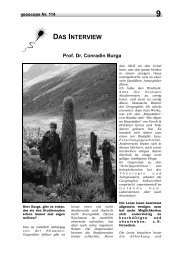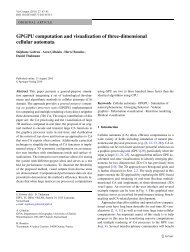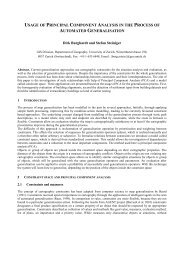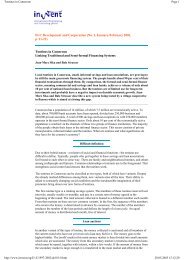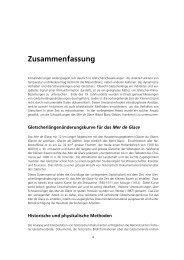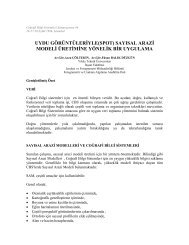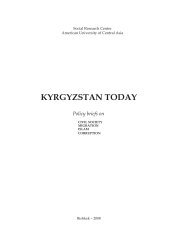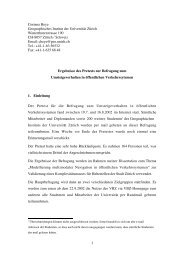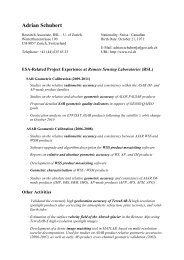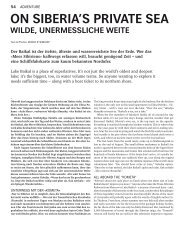Pedogenesis of Chernozems in Central Europe — A review
Pedogenesis of Chernozems in Central Europe — A review
Pedogenesis of Chernozems in Central Europe — A review
Create successful ePaper yourself
Turn your PDF publications into a flip-book with our unique Google optimized e-Paper software.
296 E. Eckmeier et al. / Geoderma 139 (2007) 288–299<br />
<strong>in</strong>corporated <strong>in</strong>to the natural A horizon and was responsible for<br />
the dark colour. Furthermore, these black soils were located<br />
only <strong>in</strong> the settlement areas and gave no evidence for a former<br />
occurrence <strong>of</strong> <strong>Chernozems</strong>.<br />
An evidence for anthropogenic <strong>in</strong>fluence on Chernozem<br />
formation could be the distribution <strong>of</strong> ‘Grauerden’ and<br />
‘Schwarzerden’ <strong>in</strong> Lower Saxony. Black and grey soils formed<br />
a patchwork with sharp boundaries between the two soil units<br />
that were <strong>in</strong>dependent <strong>of</strong> natural causes. Remarkably, Neolithic<br />
settlements were mostly situated at the edges <strong>of</strong> the black soil<br />
patches, confirm<strong>in</strong>g the idea <strong>of</strong> black soils as relics <strong>of</strong> agriculture<br />
(Gehrt et al., 2002).<br />
Farm<strong>in</strong>g may have different effects on conservation and<br />
formation <strong>of</strong> <strong>Chernozems</strong>. On the one hand, plough<strong>in</strong>g could<br />
enhance the degradation <strong>of</strong> humus and therefore <strong>Chernozems</strong><br />
(Laatsch, 1957). On the other hand, farm<strong>in</strong>g was thought to<br />
simulate steppe conditions that facilitate the persistence <strong>of</strong><br />
<strong>Chernozems</strong>, without regard<strong>in</strong>g the climatic factors (Stremme,<br />
1926). Leser and Maqsud (1975) and Zakosek (1962) suggested<br />
that agriculture could even reverse the degradation process, as<br />
<strong>in</strong> Rhe<strong>in</strong>hessen, where Late Glacial <strong>Chernozems</strong> were leached<br />
<strong>in</strong> the Early Holocene but re-formed after the erosion <strong>of</strong> the<br />
former humic horizon under farmland that seemed to simulate<br />
steppe vegetation.<br />
8. Conclusions<br />
This <strong>review</strong> on the pedogenesis <strong>of</strong> <strong>Central</strong> <strong>Europe</strong>an<br />
<strong>Chernozems</strong> revealed that the processes and factors affect<strong>in</strong>g<br />
Chernozem formation and conservation are diverse. Published<br />
results <strong>of</strong>ten conflict with the def<strong>in</strong>ition <strong>of</strong> <strong>Chernozems</strong> as<br />
steppe soils formed under cont<strong>in</strong>ental climate.<br />
We found that: (1) No absolute age and time <strong>of</strong> Chernozem<br />
pedogenesis could be stated. Stratigraphical records and<br />
radiocarbon data showed that the formation <strong>in</strong> the Late Glacial,<br />
when steppes actually occurred <strong>in</strong> <strong>Central</strong> <strong>Europe</strong>, seems to be<br />
unlikely. The radiocarbon data gave Holocene ages spread over<br />
about 3700 years, and they gave mean apparent ages <strong>of</strong> fire<br />
events (charred organic matter) or the mean residence times <strong>of</strong><br />
soil organic matter, but no absolute ages. (2) <strong>Chernozems</strong> could<br />
have formed under forest or at least under forest–steppe. Not the<br />
type <strong>of</strong> vegetation seems to dom<strong>in</strong>ate the formation <strong>of</strong> mollic<br />
horizons but soil processes which <strong>in</strong>fluence either the presence<br />
<strong>of</strong> bicarbonates or lead to reduced decomposition and therefore<br />
accumulation <strong>of</strong> organic matter. (3) Climate and relief <strong>in</strong>fluence<br />
Chernozem preservation, but <strong>of</strong>ten these factors alone are not<br />
sufficient to expla<strong>in</strong> Chernozem distribution and occurrence <strong>in</strong><br />
certa<strong>in</strong> geographical regions (e.g. Lower Saxony). (4) Man and<br />
fire may <strong>in</strong>fluence Chernozem properties through agriculture or<br />
fire management tools and could be the miss<strong>in</strong>g factors that<br />
expla<strong>in</strong> the spatial distribution <strong>of</strong> <strong>Chernozems</strong> and Phaeozems.<br />
Vegetation fire could form black soils or <strong>Chernozems</strong> that<br />
conta<strong>in</strong> high properties <strong>of</strong> charred organic matter. The black soil<br />
material <strong>in</strong> prehistoric settlements, <strong>of</strong>ten <strong>in</strong>terpreted as a pro<strong>of</strong><br />
for Chernozem distribution <strong>in</strong> the Early Holocene, is usually<br />
soil mixed with organic material deriv<strong>in</strong>g from anthropogenic<br />
activity and does not reflect natural soils.<br />
Conclud<strong>in</strong>g, the term Chernozem summarizes different types<br />
<strong>of</strong> black soils that have the same appearance but different<br />
formation histories. The FAO-WRB classification <strong>of</strong> <strong>Chernozems</strong><br />
and Phaeozems has a pedogenetical background and<br />
connects them to steppe soils. From this <strong>review</strong>, it seems that<br />
soils with Chernozem or Phaeozem properties have <strong>of</strong>ten been<br />
<strong>in</strong>terpreted as witnesses <strong>of</strong> past climate <strong>in</strong> <strong>Central</strong> <strong>Europe</strong> by<br />
their appearance, although dark or black soils could have diverse<br />
formation histories. Thus, they do not have to reflect past<br />
climate, and the classification may be mislead<strong>in</strong>g. This <strong>review</strong><br />
<strong>of</strong> <strong>Chernozems</strong> pedogenesis showed that further <strong>in</strong>vestigations<br />
are needed to uncover the different formation histories <strong>of</strong> black<br />
soils.<br />
Acknowledgements<br />
We wish to thank Stefan Pätzold and Gerd Welp for their<br />
helpful comments on a previous version <strong>of</strong> the manuscript<br />
and gratefully acknowledge the valuable contributions <strong>of</strong> two<br />
anonymous <strong>review</strong>ers.<br />
References<br />
Ad-hoc-AG Boden, 2005. Bodenkundliche Kartieranleitung. E. Schweizerbart'sche<br />
Verlagsbuchhandlung, Hannover.<br />
Albrecht, C., Kühn, P., 2003. Eigenschaften und Verbreitung schwarzerdeartiger<br />
Böden auf der Insel Poel (Nordwest Mecklenburg-Vorpommern). Greifswalder<br />
Geographische Arbeiten 29, 215–247.<br />
Alexandrovskiy, A.L., Chichagova, O.A., 1998. Radiocarbon age <strong>of</strong> Holocene<br />
paleosols <strong>of</strong> the East <strong>Europe</strong>an forest–steppe zone. Catena 34, 197–207.<br />
Altermann, M., Fiedler, H.J., 1975. Substrat-und Bodenwechsel am nördlichen<br />
Lössrand des Schwarzerdegebietes der DDR. Hercynia 12, 130–159.<br />
Altermann, M., Mania, D., 1968. Zur Datierung von Böden im mitteldeutschen<br />
Trockengebiet mit Hilfe quartärgeologischer und urgeschichtlicher Befunde.<br />
Albrecht-Thaer-Archiv 12, 539–557.<br />
Altermann, M., R<strong>in</strong>klebe, J., Merbach, I., Körschens, M., Langer, U., H<strong>of</strong>mann,<br />
B., 2005. Chernozem <strong>—</strong> soil <strong>of</strong> the year 2005. Journal <strong>of</strong> Plant Nutrition and<br />
Soil Science 168, 725–740.<br />
Altmannsberger, K.P., 1971. Identifizierung von Tschernosemen <strong>in</strong> der<br />
nördlichen Wetterau. Zeitschrift für Pflanzenernährung und Bodenkunde<br />
129, 19–28.<br />
Bailly, F., 1972. Zum Problem der Schwarzerde-Bildung <strong>in</strong> Nordd eutschland.<br />
Mitteilungen der Deutschen Bodenkundlichen Gesellschaft 15, 3–10.<br />
Baumann, W., Czerny, P., Fiedler, H.J., 1964. Archäologische und bodenkundliche<br />
Untersuchungen an e<strong>in</strong>em bandkeramischen Siedlungspr<strong>of</strong>il bei<br />
Dresden-Prohlis. Arbeits- und Forschungsberichte zur Sachsischen Bodendenkmalpflege<br />
13, 7–50.<br />
Bell, J.C., McDaniel, P.A., 2000. Mollisols. In: Sumner, M.E. (Ed.), Handbook<br />
<strong>of</strong> Soil Science. CRC Press, Boca Raton, FL, pp. E286–E307.<br />
Bird, M., 1997. Fire <strong>in</strong> the earth sciences. Episodes 20, 223–226.<br />
Blum, W.E.H., Solar, F., 1986. Die Schwarzerden Österreichs. Zeitschrift fur<br />
Pflanzenernahrung und Bodenkunde 149, 37–50.<br />
Bogucki, P., 1988. Forest farmers and stockherders. Cambridge.<br />
Bork, H.-R., 1983. Die holozäne Relief- und Bodenentwicklung <strong>in</strong> Löβgebieten.<br />
In: Bork, H.-R., Ricken, W. (Eds.), Bodenerosion, holozäne und<br />
pleistozäne Bodenentwicklung. Catena, Suppl. 3, pp. 1–93.<br />
Bronger, A., 2003. Bodengeographie der Waldsteppen und Steppen. In:<br />
Blume, H.-P. (Ed.), Handbuch der Bodenkunde. Ecomed, Landsberg/<br />
Lech, pp. 1–60.<br />
Bundesanstalt für Geowissenschaften und Rohst<strong>of</strong>fe, 1995. Bodenübersichtskarte<br />
der Bundesrepublik Deutschland 1:1000000 (BÜK 1000), Hannover.<br />
Czerny, P., 1965. Bodenkundliche Untersuchungen an e<strong>in</strong>er fossilen und e<strong>in</strong>er<br />
rezenten Schwarzerde. Albrecht-Thaer-Archiv 9, 867–881.<br />
Dokuchaev, V.V., 1883. Russkij Cernozem. Sankt Petersburg.






